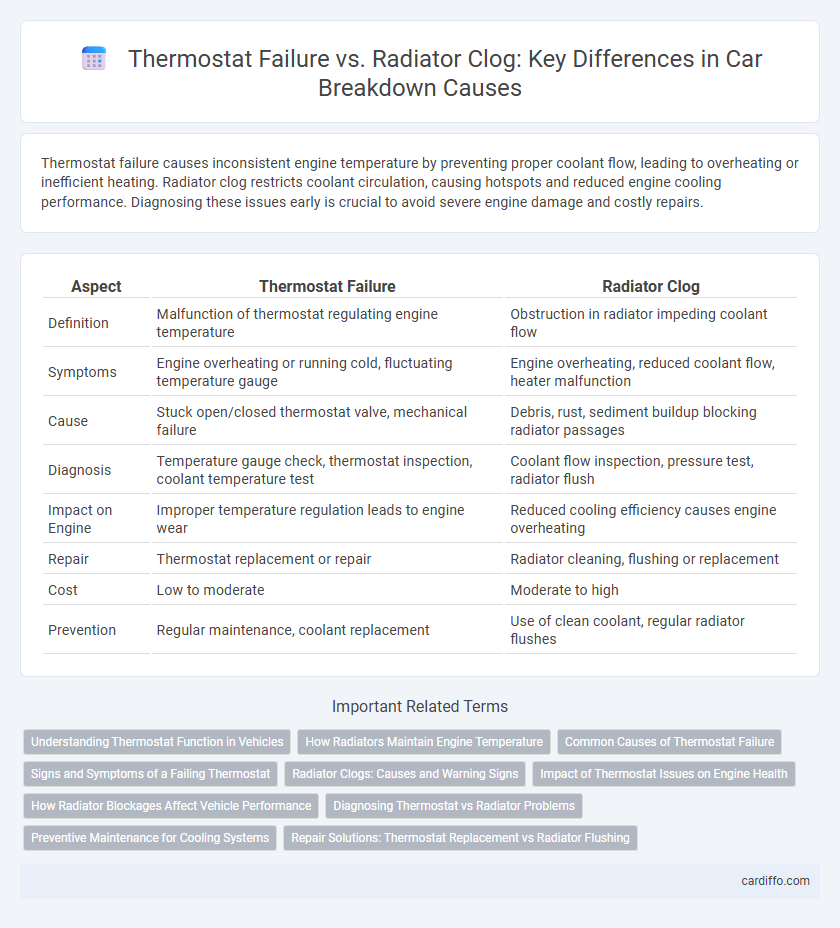Thermostat failure causes inconsistent engine temperature by preventing proper coolant flow, leading to overheating or inefficient heating. Radiator clog restricts coolant circulation, causing hotspots and reduced engine cooling performance. Diagnosing these issues early is crucial to avoid severe engine damage and costly repairs.
Table of Comparison
| Aspect | Thermostat Failure | Radiator Clog |
|---|---|---|
| Definition | Malfunction of thermostat regulating engine temperature | Obstruction in radiator impeding coolant flow |
| Symptoms | Engine overheating or running cold, fluctuating temperature gauge | Engine overheating, reduced coolant flow, heater malfunction |
| Cause | Stuck open/closed thermostat valve, mechanical failure | Debris, rust, sediment buildup blocking radiator passages |
| Diagnosis | Temperature gauge check, thermostat inspection, coolant temperature test | Coolant flow inspection, pressure test, radiator flush |
| Impact on Engine | Improper temperature regulation leads to engine wear | Reduced cooling efficiency causes engine overheating |
| Repair | Thermostat replacement or repair | Radiator cleaning, flushing or replacement |
| Cost | Low to moderate | Moderate to high |
| Prevention | Regular maintenance, coolant replacement | Use of clean coolant, regular radiator flushes |
Understanding Thermostat Function in Vehicles
A vehicle's thermostat regulates engine temperature by controlling coolant flow between the engine and radiator. When the thermostat fails, it can cause overheating or poor engine performance, mimicking symptoms similar to a radiator clog. Diagnosing thermostat malfunctions involves checking temperature fluctuations and coolant circulation to differentiate from radiator blockages.
How Radiators Maintain Engine Temperature
Radiators regulate engine temperature by circulating coolant through a heat exchanger, dissipating excess heat to prevent overheating. When a radiator becomes clogged, coolant flow is restricted, causing the engine to overheat despite the thermostat functioning properly. Thermostat failure disrupts coolant flow regulation but does not directly impede heat dissipation like a clogged radiator, making radiator maintenance crucial for optimal engine temperature control.
Common Causes of Thermostat Failure
Thermostat failure commonly results from sensor damage, electronic control issues, or mechanical wear that disrupt temperature regulation within heating systems. Unlike radiator clogs caused by debris buildup obstructing water flow, thermostat problems often stem from electrical faults or inaccurate temperature readings leading to inconsistent heating. Understanding these causes helps in diagnosing heating breakdowns more accurately and ensures timely repairs to prevent system inefficiency.
Signs and Symptoms of a Failing Thermostat
A failing thermostat often causes engine overheating or fluctuating temperature gauge readings due to improper coolant flow regulation. Symptoms include engine temperature rising quickly or failing to reach optimal operating temperature, as well as poor heater performance inside the cabin. Unlike radiator clogs that cause localized cooling issues, thermostat failure disrupts the entire cooling system's balance, leading to potential engine damage.
Radiator Clogs: Causes and Warning Signs
Radiator clogs commonly result from corrosion, sediment buildup, or debris obstructing the coolant flow, leading to inefficient engine cooling. Warning signs include engine overheating, reduced heater performance, and visible coolant leaks near the radiator or hoses. Regular maintenance and radiator flushes help prevent clog formation and maintain optimal vehicle temperature regulation.
Impact of Thermostat Issues on Engine Health
Thermostat failure disrupts the engine's temperature regulation, leading to overheating or inefficient heating cycles that cause increased engine wear and potential damage to critical components. Unlike radiator clogs that primarily impede coolant flow, thermostat issues directly affect engine warm-up times and temperature stability, resulting in reduced fuel efficiency and increased emissions. Timely diagnosis and replacement of a faulty thermostat are essential to maintain optimal engine health and prevent costly repairs.
How Radiator Blockages Affect Vehicle Performance
Radiator blockages restrict coolant flow, causing the engine to overheat and reducing overall vehicle performance. This overheating can lead to increased engine wear, decreased fuel efficiency, and potential breakdowns if not addressed promptly. Compared to thermostat failure, radiator clogs often result in localized cooling issues that directly impair the radiator's ability to dissipate heat effectively.
Diagnosing Thermostat vs Radiator Problems
Diagnosing thermostat versus radiator problems requires careful analysis of heating system behavior and temperature patterns. Thermostat failure often manifests as inconsistent room temperatures or failure to signal the boiler, while radiator clogs cause uneven heat distribution and cold spots on the radiator surface. Using a thermal camera or radiator bleed valve helps identify clogged radiators, whereas testing the thermostat circuitry and sensor ensures accurate thermostat function.
Preventive Maintenance for Cooling Systems
Thermostat failure and radiator clog are common causes of cooling system breakdowns that can be mitigated through preventive maintenance. Regular inspection and cleaning of radiators, along with timely thermostat testing and replacement, ensure optimal heat regulation and coolant flow. Implementing a scheduled maintenance plan reduces the risk of overheating, enhances engine efficiency, and extends cooling system lifespan.
Repair Solutions: Thermostat Replacement vs Radiator Flushing
Thermostat failure requires precise thermostat replacement to restore temperature regulation and prevent engine overheating, ensuring optimal vehicle performance. Radiator clog issues demand radiator flushing to eliminate blockages and improve coolant flow, maintaining efficient heat dissipation and engine cooling. Both repair solutions target critical components, with thermostat replacement resolving control malfunctions and radiator flushing addressing fluid circulation problems.
Thermostat failure vs radiator clog Infographic

 cardiffo.com
cardiffo.com